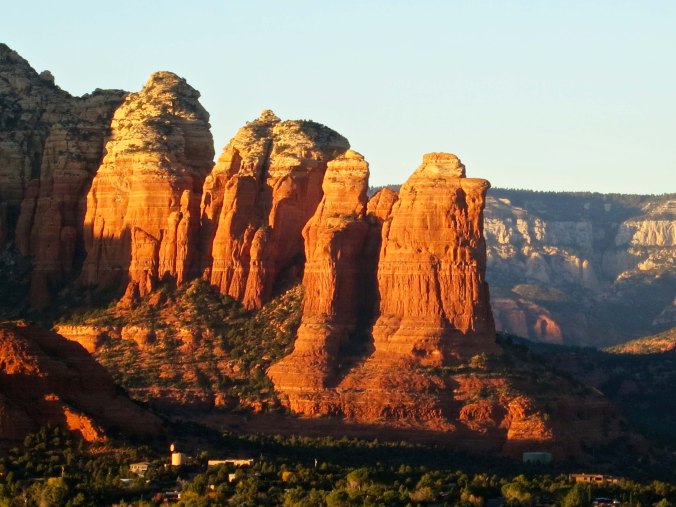
The best time to be out and about for photography in Sedona is either early in the morning or late in the afternoon when the red rocks of Sedona at are their most colorful.
It’s photo essay Wednesday so I am returning to Sedona, Arizona to wrap up my look at some of the colorful red rocks that surround the town. Last Wednesday, I focused on the formations east of town and the striking Chapel of the Holy Cross. Today I will include photos of the rock formations west of town and take a trip up the ‘mystical’ Boynton Canyon.
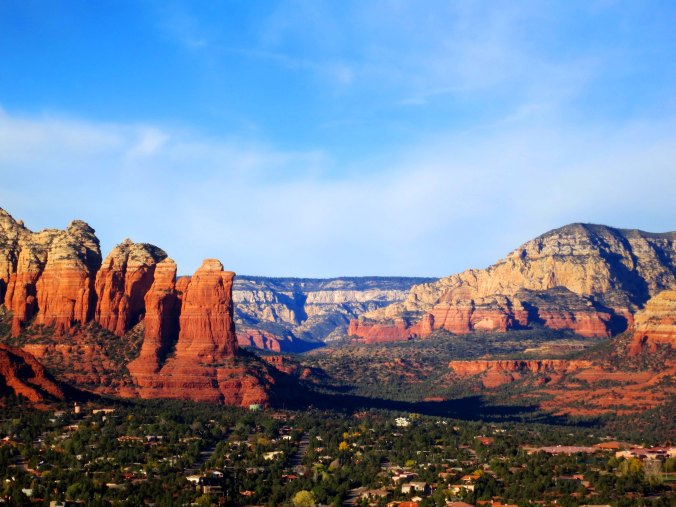
Peggy and I took these photos from up near the Sedona airport looking west across the town. The rock formation I featured at the beginning of the post is shown on the left here.
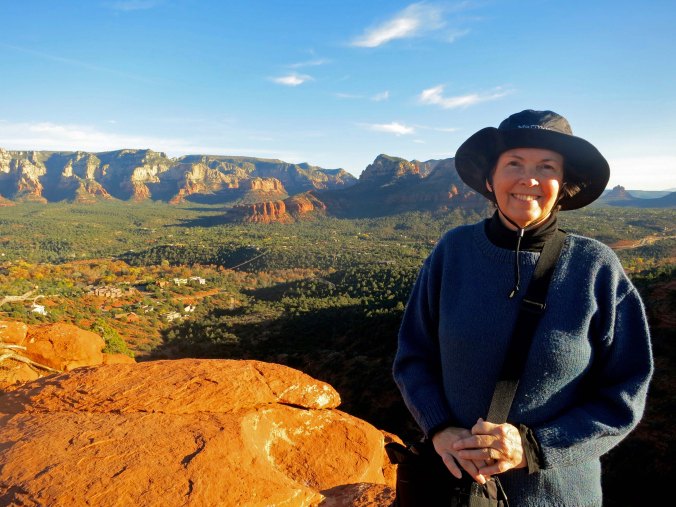
Peggy was standing on the ‘vortex’ near the airport when I took this photo. (Actually, looking at it, I think it is toward the east.)
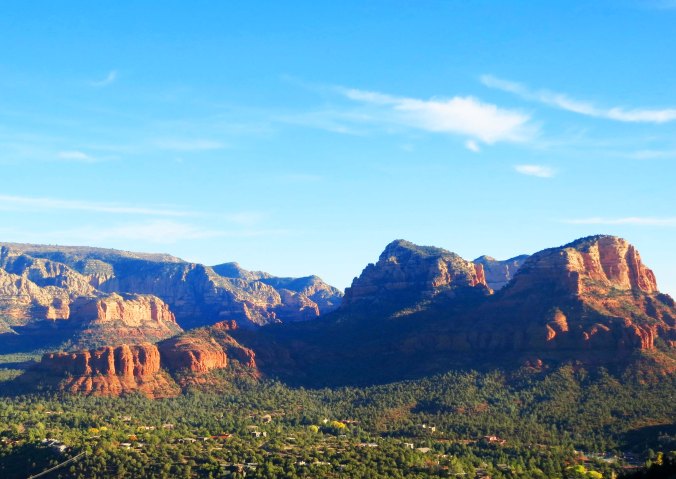
Another perspective. Possibly my blogging friend who lives in Sedona, Johanna Massey, can provide the location.

Definitely looking west here. This time the formation that I included in the first photo is on the right.

A close up…
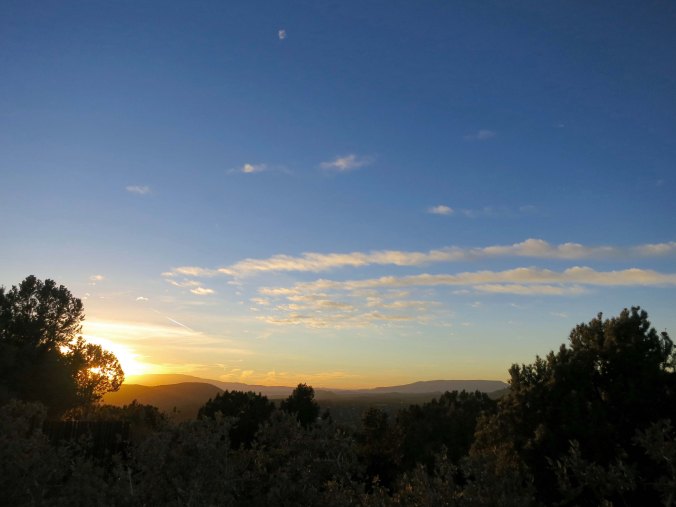
Sedona Sunset.

I liked this photo because the ridges seemed to fade off into infinity.

We took a detour on our hike up Boynton Canyon to visit with the Kachina Woman, on the left. There is supposedly another vortex in the area that emphasizes balance. (Photo by Peggy Mekemson.)

A photo of the same formation from the Boynton Canyon Trail. Some claim that the vortex is between the Kachina Woman and the knoll. Since a little balance never hurts, I stood between the two formations for a few minutes. (Photo by Peggy Mekemson.)

This is the type of view you can expect hiking up Boynton Canyon. No wonder people find the area mystical.

Each sandstone formation provides several views as you hike up the short trail. Following are examples of this one…
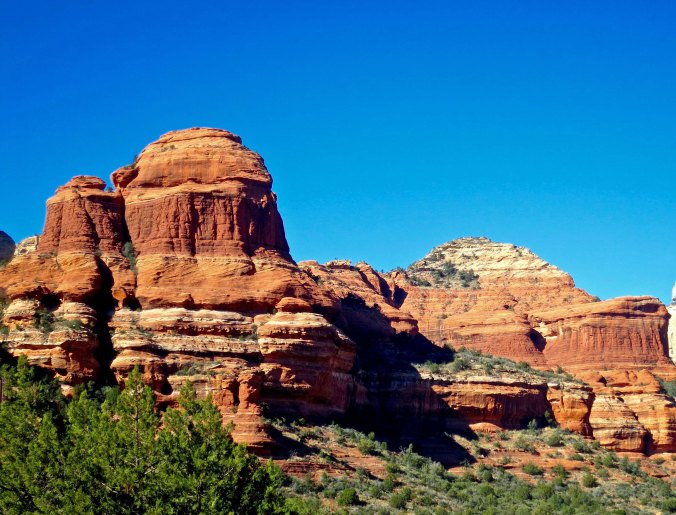


Stacked rocks and circles of rocks apparently reflect hiker’s spiritual journey up the canyon. There are so many that some people are beginning to feel that they detract from the beauty of the area. Not to worry; they are easily removed. I wonder if it gives you bad Karma.

Mineral rich waters created this dry waterfall. If I remember correctly the cave on the left belonged to early Native Americans. (Photo by Peggy Mekemson.)

This Anasazi dwelling definitely did. (Photo by Peggy Mekemson.)

Another of the impressive rock formations up Boynton Canyon.

And another!

That’s it for today, folks!
FRIDAY’S Blog-a-Book POST: The great tree race where my brother and I face off against each other in a death-defying race up and down the 70-foot tall Incense Cedar tree in the Graveyard.
MONDAY’S Travel Blog POST: Where Homeland Security checks out our food supply for the Colorado River trip.
WEDNESDAY’S Photo Essay POST: A visit to the ancient Roman city of Pompeii, Italy that was buried by the volcanic eruption of Mt. Vesuvius in 79 CE.
SaveSave
Beautiful colours everywhere.
On and on and on, AC! –Curt
Nature is so perfect.
Even more so when we allow ourselves the time to stop and enjoy it, Bojana! –Curt
I can’t agree more.
These rock formations and blue skies are just stunning!
It’s beautiful country for sure, Emily. A bit drier than Ireland. 🙂 –Curt
Could be the setting for a John Ford movie!
Could very well have been, Andrew! It’s not that far from Hollywood. –Curt
Absolutely gorgeous. I really need to visit Arizona. Stat.
Surprised you haven’t been there, Carrie. Tons of gorgeous things to see in the state. Highly recommend it. –Curt
They look like Temples that monks in Tibet might live in or Egyptian Gods.
I have to agree, G! Certainly enough people believe that they are sacred sites. I don’t know that, but I do know they are special. –Curt
Sensational pics. That first one reminds me of The Three Sisters in Australia’s Blue Mountains.
Gerard was just telling me that Uluru beats Sedona’s rocks for color. Now with the Blue Mountains, there is another site in Australia I have to see, Peggy. 🙂 Thanks. –Curt
As for redness on rocks, I still reckon our own Australian red rock named Uluru beats them all. In fact it is also the world’s biggest rock as well. Soon, no one will be allowed to climb it. It is a sacred site and hordes of people climbing it, taking selfies is found to be offensive to the original owners, the true indigenous Australians.
Great photos again, Curt. Thank you for all those wonderful journeys.
Someday, I will make there to see Uluru, Gerard! And I don’t blame the Aboriginals!
Always glad to have you along on my journeys. Thanks. –Curt
I was most impressed by the dry waterfall. And Peggy’s smiling face at the end!
The waterfall was amazing, Gunta. And I always like Peggy’s smiling face. It happens all the time. 🙂 –Curt
Glad to hear your Peggy wears that smile a lot (bet you keep her happy!) My Eric seems to do the same for me. Life is good! 😀
Life is… 🙂
Definitely some colorful country down there. Have you been to the Oregon “Vortex”? It’s not far from your stomping grounds.
Peggy went there with our grandkids, Dave, and had fun. I haven’t been there. –Curt
Great photos, Curt. You and Peggy both look like you are just having the best time among the mystical red rocks. I honestly have to say that you have me stumped as to where you are standing for the photo. But…I have fixed on one area I need to positive ID in real time and get back to you.
Now about those Vortexes: The story I was told, and know there are many versions of all stories Sedona…Page Bryant, a self proclaimed psychic, who lived in Sedona during the very beginning of the New Age movement in the US, claimed to have discovered powerful energy sources, with either male or female energies, in locations all about some of Sedona’s red rock formations. She claimed the energies were as strong as those of Stonehenge, Machu Picchu, the Great Pyramids, and Ayars Rock in Australia. Many of the places had long been, and remain sacred sites to area Tribes and their members.
In 1994 Page Bryant left Sedona to move to North Carolina…where she was pleased to announce her discovery of Vortexes exceeding the power and strength of Sedona’s located in the Smoky Mountains.
All my best to you and Peggy for a peaceful weekend.
Thanks, Johanna, for the details on the vortexes. It could be that Page will find vortexes wherever she travels. 🙂 The Red Rocks of Sedona seem plenty sacred to me vortexes on not, however!
We were standing on the Vortex rock below the airport, I think. –Curt
You’ve captured the rocks at the optimal time of day — that red is vivid. I also love the striations that give the rocks their character and individuality. The stack of rocks intrigues me. We see these on rocky crags near the ocean (such as Acadia National Park) as well as at rock formations in places like Utah. Must be universal!
Anywhere there have been lakes or seas where mud, sand and sealife settle to the bottom! Of course, sometimes the layers have been folded almost beyond recognition. –Curt
Awesome write-up as well as the picture-esque recollections.
Thanks, V! –Curt